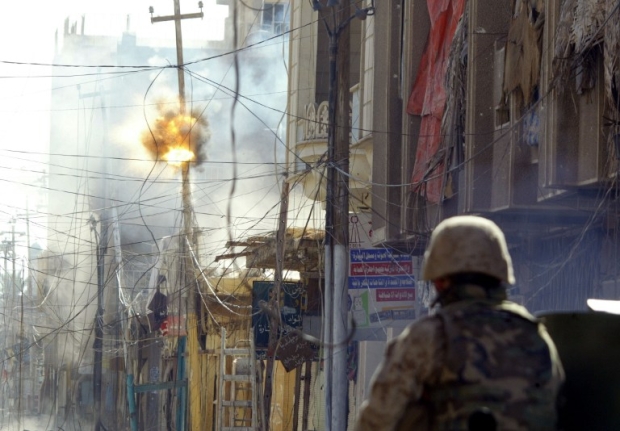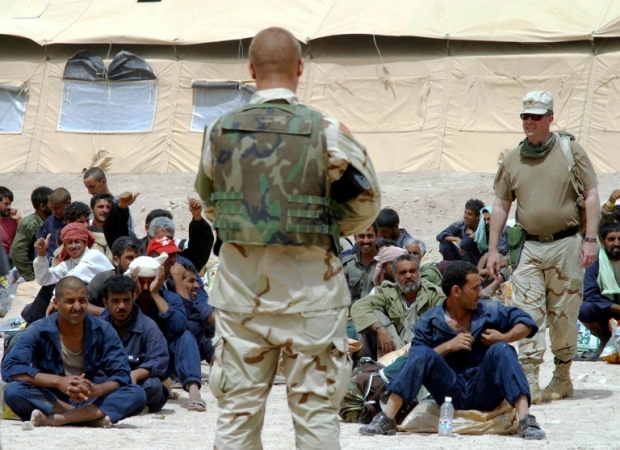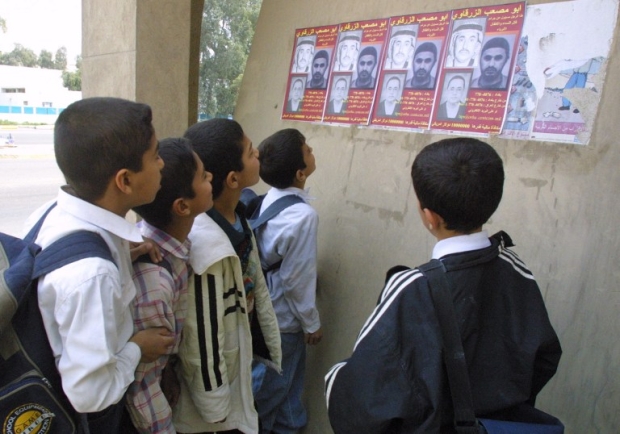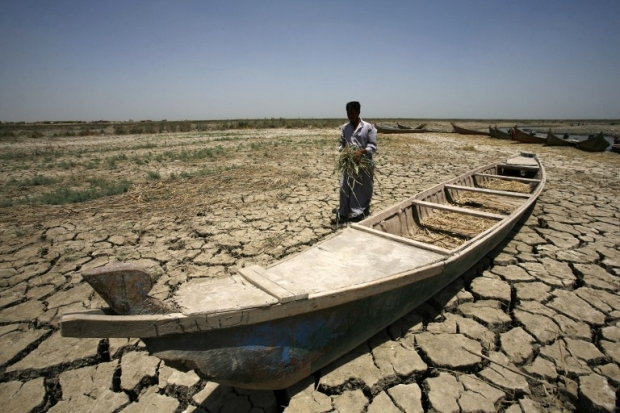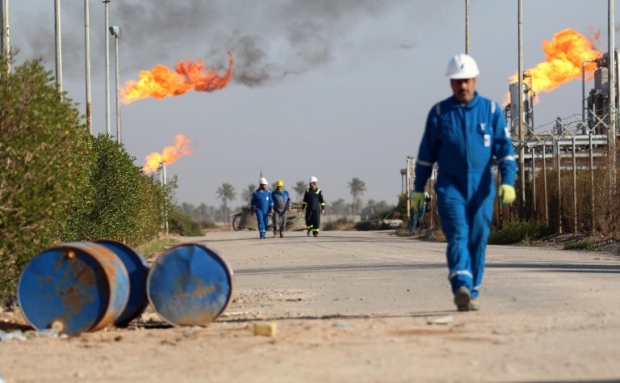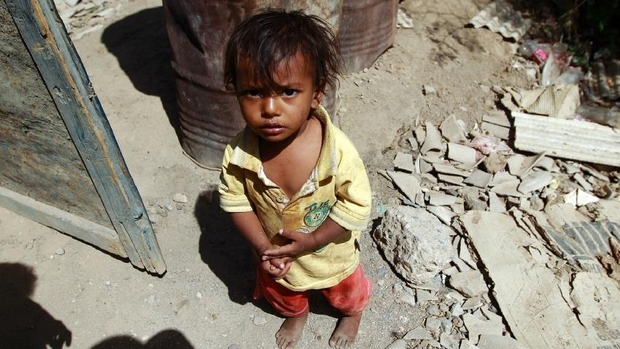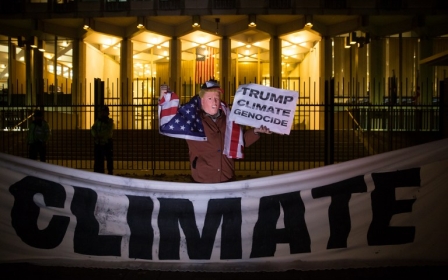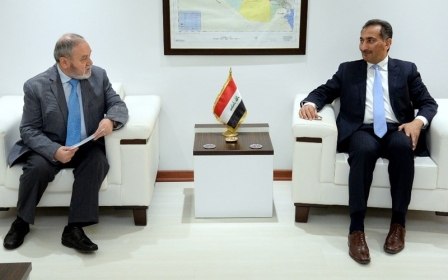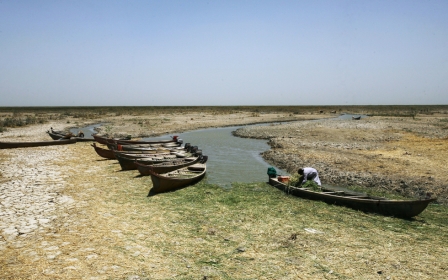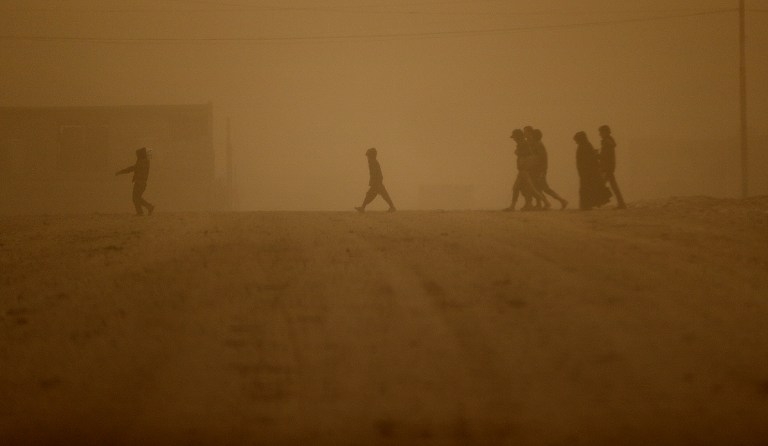
After Mosul: The coming break-up of Iraq and end of the Middle East
All eyes are on the battle for Mosul. Will the coalition defeat the Islamic State (IS) or not? In the end, it won't matter. If we have learned anything from the last 14 years of fighting the "war on terror" in Iraq, it is that today's hard-won victories can very quickly metamorphose into tomorrow's epic disasters.
Whether you're pro or anti-war, the facts speak for themselves: the toppling of Saddam Hussein created a vacuum that was filled by al-Qaeda extremists, who previously had no presence in Iraq, and who rapidly transformed and expanded into the apocalyptic force known as the Islamic State.
As states become weaker, unable to cope with environmental, energy and economic challenges, the vacuum is being filled by extremists
But the very nature of the battle for Mosul is one sign among many revealing that the Middle East as we know it no longer exists, and will never return. The region is deep in the throes of an irreversible geopolitical transition to a new, unstable disorder.
Before 9/11, several neo-conservative strategists saw their role as marshalling US imperial power to accelerate the break-up of the Middle East. In reality, the Middle East that we know is breaking up under the pressure of deeper, slow-working biophysical processes: environmental, energetic, economic. These processes are unravelling the power of regional states from behind the scenes.
As states become weaker, unable to cope with their fundamental environmental, energy and economic challenges, the vacuum is being filled by extremists. But intensifying the fight against extremists doesn't deal with those deeper issues. Instead, it is producing more extremists.
The war in Mosul will be no exception.
From Fallujah to Mosul
"It's Fallujah on a grander scale," said Ross Caputi, a former US marine who participated in the second siege of Fallujah in November 2004.
"I've been hearing a lot of horror stories about civilian casualties coming out of Mosul. An aid worker friend of mine was trying to recruit volunteer doctors to work in a surgical unit in Erbil, where many of the more serious cases were being redirected. She told me the situation is worse than it's being portrayed in the media."
Caputi's concerns are corroborated by the findings of AirWars, whose February casualty report says that the US-led coalition is now killing more civilians in air strikes than Russia. In the first week of March, the group found that between 250 and 370 civilians were killed by US-led coalition forces storming western Mosul, exponentially higher than the US count of just 21 civilian deaths from bombing since November 2016.
Although the Russians have killed more overall, Airwars noted that Iraqi government operations to recapture east Mosul from IS "came at significant cost to non-combatants trapped in the city. During January, claimed civilian deaths from Coalition actions more than doubled compared to December".
The war on Mosul is the culmination of a longer sectarian war that preceded the emergence of IS. The US-backed Iraqi government has, since inception, marginalised the Sunni minority. As the Sunni insurgency against the occupation escalated, US and Iraqi authorities together painted it as little more than an extremist uprising by fanatics. In reality, it was the occupation itself that radicalised the insurgency and pulled al-Qaeda into its vortex.
Caputi saw first-hand as a soldier in Fallujah that the insurgency in 2004 was not, at that time, dominated by al-Qaeda. Instead, according to him, on the pretext of targeting al-Qaeda insurgents, the US military was for the most part targeting and killing Iraqi civilians.
Eventually, US troops moved to take control of the hospital on the eve of the main US assault on Fallujah. This, Caputi recalls, was considered an "information operations" success for the US.
The US military's destruction of Fallujah was accompanied by the role of the central Shia Iraqi government in painting the predominantly Sunni town as a hotbed of extremism.
The war on Fallujah never came to an end. Armed by the US, Iraqi forces have intermittently attacked and bombed Fallujah almost daily since 2012. These operations stepped up after the city had been captured by IS in January 2014.
In this period, Syria's Bashar al-Assad allowed al-Qaeda operatives to move freely across the border, to augment the Iraqi insurgency against American forces. This policy, which continued through to 2012, contributed to the destabilisation of Iraq.
But al-Qaeda would not have been able to intensify this foothold in Iraq if not for the deeply sectarian violence of the US military and Iraqi government towards the Sunni minority, as exemplified in Fallujah, that led some among them to accept IS as a "lesser evil" - and led some to become radicalised enough to join the movement.
The warning
US officials were warned of this outcome early on during the occupation. Yet they and their Iraqi counterparts have learned little from this recent history.
According to Anne Speckhard, director of the International Center for the Study of Violent Extremism and the Pentagon consultant who designed the psychological and religious portions of the detainee rehabilitation programme in Iraq, terrorists were recruiting and training prisoners inside Camp Bucca.
The US began trying to intervene and deradicalise those it could, but the rehabilitation programme she designed was never actually implemented.
But the military sweeps that had put al-Baghdadi and others into the Bucca detention camp were indiscriminate – part of an invasion and occupation that targeted Iraqi civilians wholesale, and disproportionately targeted Sunnis. According to Speckhard, the internal estimates by US authorities in late 2006 confirmed that only 15 percent of the detainees at Camp Bucca were "true extremists and adherents to the al-Qaeda ideology".
When Speckhard interviewed former prisoners of Camp Bucca in Jordan in 2008, she discovered that US officials had never meaningfully implemented the detainee rehabilitation programme. The former prisoners told her that imams handpicked by the authorities would stand outside the fence of the prison, reading Islamic verses, while detainees laughed and spat at them. "This was not the engagement I had envisioned," she said.
Speckhard said not much abuse was reported at Camp Bucca. "Prisoners told me they were tortured by Iraqis and very happy to have fallen into our hands rather than theirs as a result," she said.
But others - including former soldiers and prisoners - speak of the abuses at the prison firsthand. Anecdotal evidence like theirs would suggest that, under US tutelage, Camp Bucca, which held 24,000 mostly Sunni prisoners, was the site of systematic abuse and torture so brutal that it resulted in death.
A 2004 US Army classified report, released by the American Civil Liberties Union (ACLU) in 2006, documented the existence of 62 separate investigations into allegations of prisoner abuse at US detention centres across Iraq, including Camp Bucca.
When Speckhard interviewed former prisoners of Camp Bucca, she discovered that US officials had never meaningfully implemented the detainee rehabilitation programme
The eye-watering list of abuses is hard to read, and would have made Saddam proud: physical and sexual assaults, mock executions, threatening to kill an Iraqi child to "send a message to other Iraqis," stripping detainees, beating them, shocking them with a blasting device, throwing rocks at handcuffed Iraqi children, choking detainees with knots of their scarves, and interrogations at gunpoint.
But there were deeper issues at play. Major General Douglas Stone, then commanding general of the Detainee Task Force, began authorising "quick releases of detainees putting them through a four-day programme that basically checked a lot of boxes and only engaged them superficially, if at all," said Speckhard. "That may have been fine for the 85 percent who were not adhering to the militant jihadi ideology." But it had no affect at all on the hardcore.
Middle East Eye contacted General Stone for comment but did not receive a reply by the time of publication.
At the time, Speckhard recalls, she warned General Stone that the rehabilitation "will only work if the politics of Iraq support it. A man who joined the militant jihad because you killed his sister may agree to give up engaging in violence, but if you kill his brother next, he'll go right back to it."
Divide and rule
"The mass releases were done to keep the Sunni tribes happy," she said. "We were releasing the detainees to support the Awakening, to build up the Sunni insurgency against al-Qaeda."
But the US military hadn't decided to mass release these prisoners as a kindness. There was a dubious, dangerous strategic context:
The Awakening represented a US-led effort to mobilise Sunni tribal leaders against al-Qaeda in Iraq. It was believed that the mass release of Iraqi detainees would help engender confidence in American intentions with the Sunni tribes, and augment them with manpower. But US intelligence agencies also knew that many of those who would go on to fight against al-Qaeda in Iraq under the Awakening were often themselves former al-Qaeda sympathisers.
It was classic counterinsurgency strategy – attempt to break the resistance by turning parts of the resistance against itself. As I previously reported for MEE, elements of the strategy are described quite candidly in an insightful RAND Corporation report commissioned by the US Army Training and Doctrine Command's Army Capability Integration Centre, published in 2008.
What I didn't emphasise in that story is that the RAND report explicitly acknowledged that its proposed "divide and rule" strategy to exploit Sunni-Shia sectarian tension across the region was then being implemented in Iraq by US forces. US forces must use covert strategies to sow "divisions in the jihadist camp. Today in Iraq such strategy is being used at the tactical level," said the report.
The idea was to fracture the insurgency from within, by co-opting its wider support base in the Sunni population. It sounds clever in theory, but in practice we now know that the strategy sowed the seeds of the birth of IS.
But the Americans had made their bed, and they were laying in it. While funnelling support to a whole spectrum of disgruntled Sunni jihadists with various past affiliations to al-Qaeda, the US was simultaneously backing the central Shia government of Iraq. Both sides in receipt of US support were heightening sectarian tensions. And the Iraqi government in particular increasingly displayed a brutal contempt for the Sunni minority. In this context, the US strategy was doomed from the start.
"Since withdrawing from Iraq, the anti-Sunni sectarian bias of the Iraqi government under [then prime minister Nuri al-]Maliki and Shia security forces became emboldened," Speckard said.
"Under Maliki, Iraqi authorities even profiled and arrested top Sunni politicians. This reinforced biases within the Sunni tribes, and increased the sorts of sectarian resentments that led a minority of Sunnis to support IS. These were the same sentiments that originally fuelled support for al-Qaeda. Of course, the sectarian violence of the late Abu Musab al-Zarqawi, former leader of al-Qaeda in Iraq, compounded this problem."
The next insurgency
While IS atrocities in Fallujah, Mosul and beyond, have undermined its traction amongst local Sunnis, atrocities by the US-backed anti-IS coalition are alienating the population in the long-run.
"On the whole, I don't think people in Mosul look at the anti-IS coalition as their heroic saviours, although I do think they've changed their assessment about IS being the lesser evil," Ross Caputi said.
In early 2014, IS was tolerated by some as a fringe part of a diverse uprising against the US-backed central government. IS crimes have changed that. So the coalition might well succeed in killing off the terror group's remaining chain of command in Iraq. But will this be the end of the war?
One top Kurdish intelligence official doubts it. Lahur Talabany, a senior counter-terrorism official in the Kurdish Regional Government (KRG), believes that even if IS is defeated in Mosul, the group will continue and escalate its insurgency from mountains and deserts.
"Mosul will get taken … I think it is the asymmetric warfare that we need to be worried about," he said.
While IS might disband, another more extreme group would probably emerge in its place if nothing is done to resolve Iraq's deepening sectarian tensions. "… Maybe not Daesh (Islamic State), but another group will pop up under a different name, a different scale. We have to be really careful," Talabany told Reuters.
'These operations are creating the context for a long-term insurgency against the Iraqi government and Iranian influence throughout the region'
- Ross Caputi
"These next few years will be very difficult for us, politically … We know some of these guys escaped.
"They are trying to send people out for the next phase, post-Mosul, to go into hiding and sleeper cells.
"You have to try and find them when they go underground, you have to try and flush out these sleeper cells. There will be unrest in this region for the next few years, definitely."
Caputi agrees that a "victory" in Mosul could just be the beginning of a prolonged conflict, but he is sceptical of talk of "sleeper cells". If the strategy is to kill every single last IS member, it will fail, he warns. And that's why the current operation will not end the war – because it's not dealing with the conditions that created IS in the first place.
"These operations are creating the context for a long-term insurgency against the Iraqi government and Iranian influence throughout the region," Caputi told me. "The phenomenon of IS is more the product of several historical, social, and political conditions, which this war against IS has done nothing to change. Since those conditions are still there - injustice, poverty, political repression - I expect we'll see continued insurgency… Sunni Iraqis will remain second class citizens under this government and they will not stand for it."
System failure
Meanwhile, the conditions that laid the groundwork for the rise of IS are worsening. Those conditions include what's happened on the surface of geopolitics: the destruction of Iraqi society under decades of war and occupation; the collapse of Syria into internecine warfare due to Syrian President Bashar al-Assad's comprehensive destruction of civilian infrastructure, and atrocities by extremists who have increasingly captured the rebel movement with the support of the Gulf states and Turkey.
But accelerating the conflict from behind the scenes are fundamental biophysical processes unfolding across the region.
I have studied these processes and published my findings on them in a new scientific monograph, Failing States: Collapsing Systems: BioPhysical Triggers of Political Violence, published by SpringerBriefs in Energy.
Among my findings is that IS was born in the crucible of a long-term process of ecological crisis. Iraq and Syria are both experiencing worsening water scarcity. A string of scientific studies has shown that a decade-long drought cycle in Syria, dramatically intensified by climate change, caused hundreds and thousands of mostly Sunni farmers in the south to lose their livelihoods as crops failed. They moved into the coastal cities, and the capital, dominated by Assad's Alawite clan.
Meanwhile, Syrian state revenues were in terminal decline because the country's conventional oil production peaked in 1996. Net oil exports gradually declined, and with them so did the clout of the Syrian treasury. In the years before the 2011 uprising, Assad slashed domestic subsidies for food and fuel.
While Iraqi oil production has much better prospects, since 2001 production levels have consistently remained well below even the lower-range projections of the industry, mostly because of geopolitical and economic complications. This weakened economic growth, and consequently, weakened the state's capacity to meet the needs of ordinary Iraqis.
Drought conditions in both Iraq and Syria became entrenched, exacerbating agricultural failures and eroding the living standards of farmers. Sectarian tensions simmered. Globally, a series of climate disasters in major food basket regions drove global price spikes. The combination made life economically intolerable for large swathes of the Iraqi and Syrian populations.
Outside powers – the US, Russia, the Gulf states, Turkey and Iran – all saw the escalating Syrian crisis as a potential opportunity for themselves. As the ensuing Syrian uprising erupted into a full-blown clash between the Assad regime and the people, the interference of these powers radicalised the conflict, hijacked Sunni and Shia groups on the ground, and accelerated the de-facto collapse of Syria as we once knew it.
From this maelstrom, as billions of dollars of funding poured in from the Gulf states and Turkey into the financing of armed rebels – most of which ended up empowering the most extremist factions – the monstrosity known as Islamic State emerged.
Meanwhile, across the porous border in Iraq, drought conditions were also worsening. As I write in Failing States, Collapsing Systems, there has been a surprising correlation between the rapid territorial expansion of IS, and the exacerbation of local drought conditions. And these conditions of deepening water scarcity are projected to intensify in coming years and decades.
As states like Iraq and Syria begin to fail as HSD accelerates, those responding – whether they be the Iraqi and Syrian governments, outside powers, militant groups or civil society actors – don't understand that the breakdowns happening at the levels of state and infrastructure are being driven by deeper systemic ESD processes.
Instead, the focus is always on the symptom: and therefore the reaction almost always fails entirely to even begin to address earth system disruption.
So Assad, rather than recognising the uprising against his regime as a signifier of a deeper systemic shift – symptomatic of a point-of-no-return driven by bigger environmental and energy crises – chose to crack down on his narrow conception of the problem: angry people.
Equally, the Syrian resistance saw the problem as little more than the nefarious, corrupt and extractive nature of the oppressive Assad regime, without noticing that his regime was now being undone by deeper, biophysical processes that – even without his regime – will continue to unfold.
And so, as Syria has become a failed state, no one is dealing with the very escalating process of earth system disruption that is driving human system destabilisation across the region. This is not surprising. If anything acts as an impediment to dealing with root causes, to re-building environmental resilience, new energy systems and enhancing social and political empowerment – it is war.
The slow demise of the old oil order
This myopia still afflicts officialdom in Iraq, which is not as far down the road of systemic state failure as Syria. US and Iraqi officials are pinning their hopes on the ephemeral dream of converting the country into a booming oil producer, capable of pumping out profitable petroleum at a rate to rival its neighbour, Saudi Arabia.
It is, quite literally, a pipe dream.
In my new study, I cite robust data showing that Iraq's conventional oil production is forecast to peak within a decade, by around 2025, before declining. This means that after 2025, the principal source of the central government's revenues will begin to concertedly decline.
It will only be a matter of time, in this context, before the state – without identifying a new and sustainable source of income – will be forced to retract. In this scenario, we may see the central government increasingly unable to maintain basic social expenditures, which are already deeply strained. On a business-as-usual trajectory, Iraq as we know it is headed for full-blown systemic state failure by approximately 2040.
In short, while earth system disruption slowly and quietly unravels state power, short-sighted responses result in human system destabilisation, leaving the vacuum to be filled increasingly by those seeking autonomy from the central government, and the extremists who are at open war with it.
It's not just Iraq and Syria who sit on the path of systemic state failure. Other countries in the region exhibit similar dynamics.
Yemen
In Yemen, for instance, conventional oil production peaked in 2001 and has now virtually collapsed according to the latest data. As of August 2016, net exports of oil have reduced to “a trickle” and have so far stayed that way
Post-peak Yemen, like Syria and Iraq, exhibits similar features of intensifying water and food scarcity. Electricity production is intermittent, and nationwide fuel shortages are routine, forcing factory closures and prompting foreign companies and international organisations to suspend operations, withdrawing capital and personnel.
This means not only that the state's main source of revenues is almost obsolete, but that its capacity to respond to the crisis in a way that is not simply reactive to the symptoms has been fatally inhibited.
The Gulf states are next in line. Collectively, the major oil producers might have far less oil than they claim on their books. Oil analysts at Lux Research estimate that OPEC oil reserves may have been overstated by as much as 70 percent. The upshot is that major producers like Saudi Arabia could begin facing serious challenges in sustaining the high levels of production they are used to within the next decade.
A new peer-reviewed study in the journal Energy Policy by Dr Steven Griffiths, vice president for research at the Masdar Institute for Science and Technology in Abu Dhabi, corroborates these concerns. Dr Griffiths points out that OPEC countries in the Middle East and North Africa in particular may have exaggerated their proven reserves. He notes evidence that "Kuwait's proved reserves may be closer to 24 billion barrels [than the 101 billion barrels cited by OPEC] and Saudi Arabia's reserves may have been overstated by as much as 40 percent".
Another clear example of exaggeration is in natural gas reserves. Griffiths argues that "resource abundance is not equivalent to an abundance of exploitable energy".
While the region holds substantial amounts of natural gas, underinvestment due to subsidies, unattractive investment terms, and "challenging extraction conditions" have meant that Middle East producers are "not only unable to monetise their reserves for export, but more fundamentally unable to utilise their reserves to meet domestic energy demands".
This is particularly prominent in the Gulf states: "The GCC [Gulf Cooperation Council] countries, for instance, have substantial associated and non-associated natural gas reserves, but all GCC countries with the exception of Qatar are now faced with a shortage of domestic natural gas supply."
Griffiths thus concludes that "stated proved hydrocarbon reserves in the MENA region can be misleading with regard to the outlook for regional energy self-sufficiency".
Food threat
While this "does not necessarily imply an imminent shortage of oil, it does raise the question about peak conventional oil". He goes on to spell out the potentially destabilising implications: "MENA countries that have historically relied on resource rents to support social, political and economic agendas face risks regarding their actual timelines for implementing reforms needed for their 'post-oil' economies."
Oil depletion is only one dimension of the ESD processes at stake. The other is the environmental consequence of exploiting oil.
Over the next three decades, even if climate change is stabilised at an average rise of 2 degrees Celsius, the Max Planck Institute forecasts that the Middle East and North Africa will still face prolonged heatwaves and dust storms that could render much of the region "uninhabitable". These processes could destroy much of the region's agricultural potential.
If nothing is done to address these challenges, the period from 2020 to 2030 will see Middle East oil exporters experiencing a systemic convergence of climate, energy and food crises. These crises will weaken their capacities to deliver goods and services to their populations. And the process of systemic state failure we are seeing unfold in Iraq, Syria and Yemen will extend across the region.
Broken models
While some of these climate processes are locked in, their impacts on human systems are not. The old order in the Middle East is, unmistakeably, breaking down. It will never return.
But it is not – yet – too late for East and West to see what is actually happening and act now to transition into the inevitable future after fossil fuels.
The battle for Mosul cannot defeat the insurgency, because it is part of a process of human system destabilisation. That process offers no fundamental way of addressing the processes of earth system disruption chipping away at the ground beneath our feet.
It is not too late for East and West to see what is actually happening and act to transition into the inevitable future after fossil fuels
The only way to respond meaningfully is to begin to see the crisis for what it is, to look beyond the dynamics of the symptoms of the crisis – the sectarianism, the insurgency, the fighting – and to address the deeper issues. That requires thinking about the world differently, reorienting our mental models of security and prosperity in a way that captures the way human societies are embedded in environmental systems – and responding accordingly.
At that point, perhaps, we might realise that we're fighting the wrong war, and that as a result no one is capable of winning.
As the old oil order in the Middle East collapses over the next few years and decades, governments, civil society, business, and investors have an opportunity to build grassroots, post-fossil fuel structures that could pave the way for new forms of ecological resilience and economic prosperity.
This essay was amended on 16 March 2017 and 21 March 2017 to clarify quotes attributed to Dr Anne Speckhard.
- Nafeez Ahmed PhD is an investigative journalist, international security scholar and bestselling author who tracks what he calls the 'crisis of civilisation.' He is a winner of the Project Censored Award for Outstanding Investigative Journalism for his Guardian reporting on the intersection of global ecological, energy and economic crises with regional geopolitics and conflicts. He has also written for The Independent, The Sydney Morning Herald, The Age, The Scotsman, Foreign Policy, The Atlantic, Quartz, Prospect, New Statesman, Le Monde diplomatique and New Internationalist. His work on the root causes and covert operations linked to international terrorism officially contributed to the 9/11 Commission and the 7/7 Coroner's Inquest.
The views expressed in this article belong to the author and do not necessarily reflect the editorial policy of Middle East Eye.
Photo: Iraqi residents flee their neighbourhood to safer locations during a heavy dust storm in an eastern district of Mosul on 2 December 2016 as soldiers of the Iraqi Special Forces battle against Islamic State (IS) group (AFP).
This article is available in French on Middle East Eye French edition.
New MEE newsletter: Jerusalem Dispatch
Sign up to get the latest insights and analysis on Israel-Palestine, alongside Turkey Unpacked and other MEE newsletters
Middle East Eye delivers independent and unrivalled coverage and analysis of the Middle East, North Africa and beyond. To learn more about republishing this content and the associated fees, please fill out this form. More about MEE can be found here.


